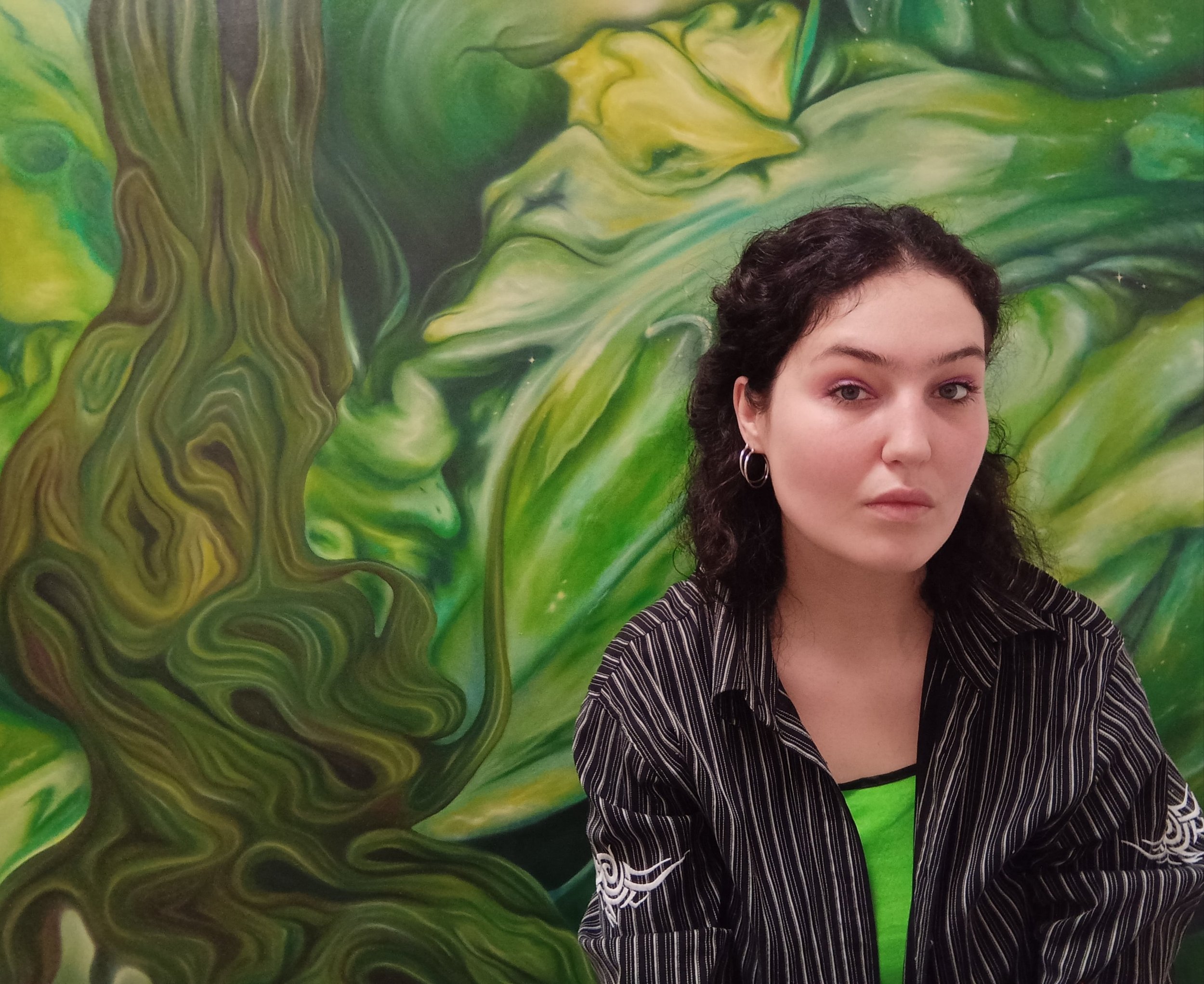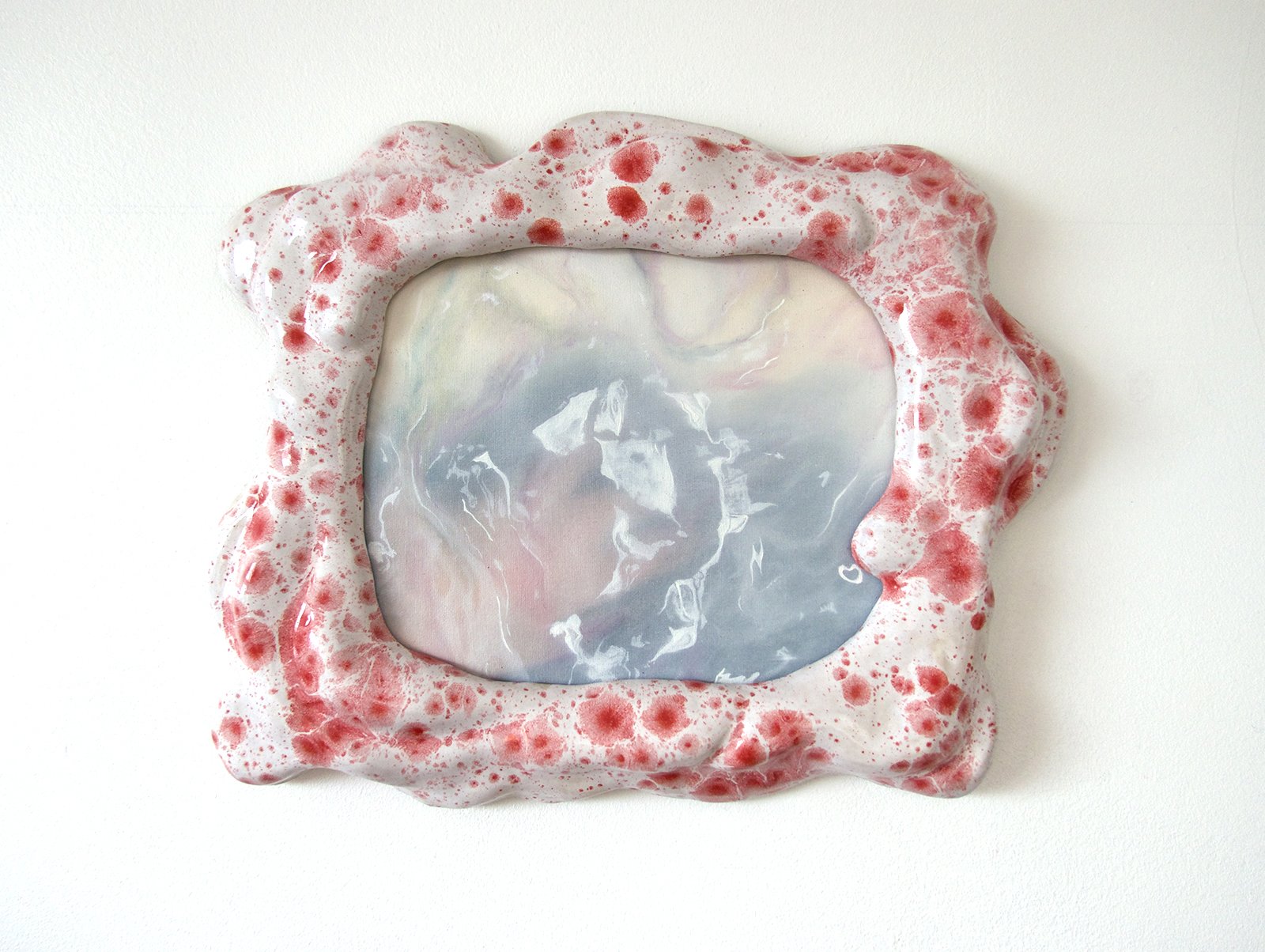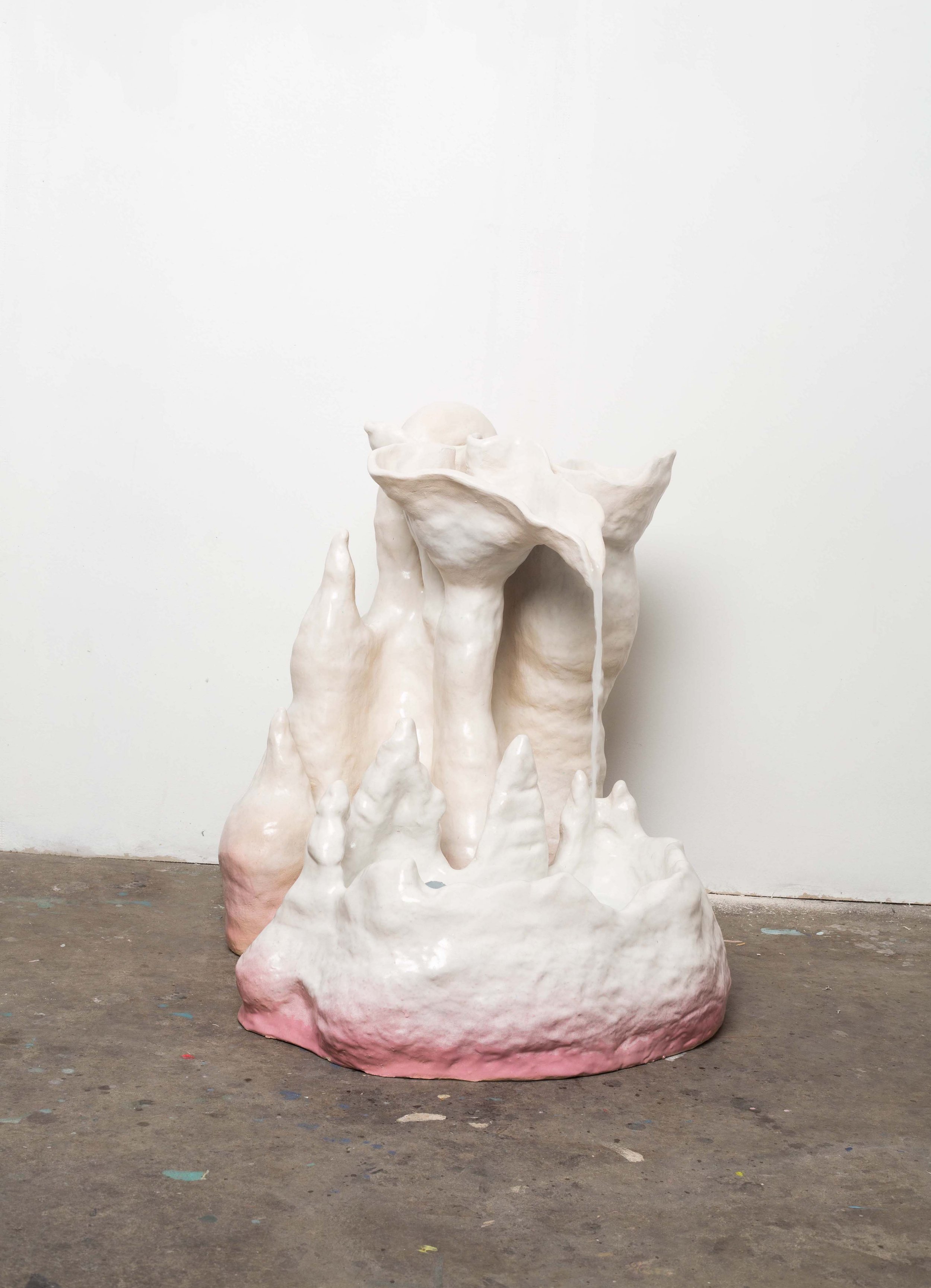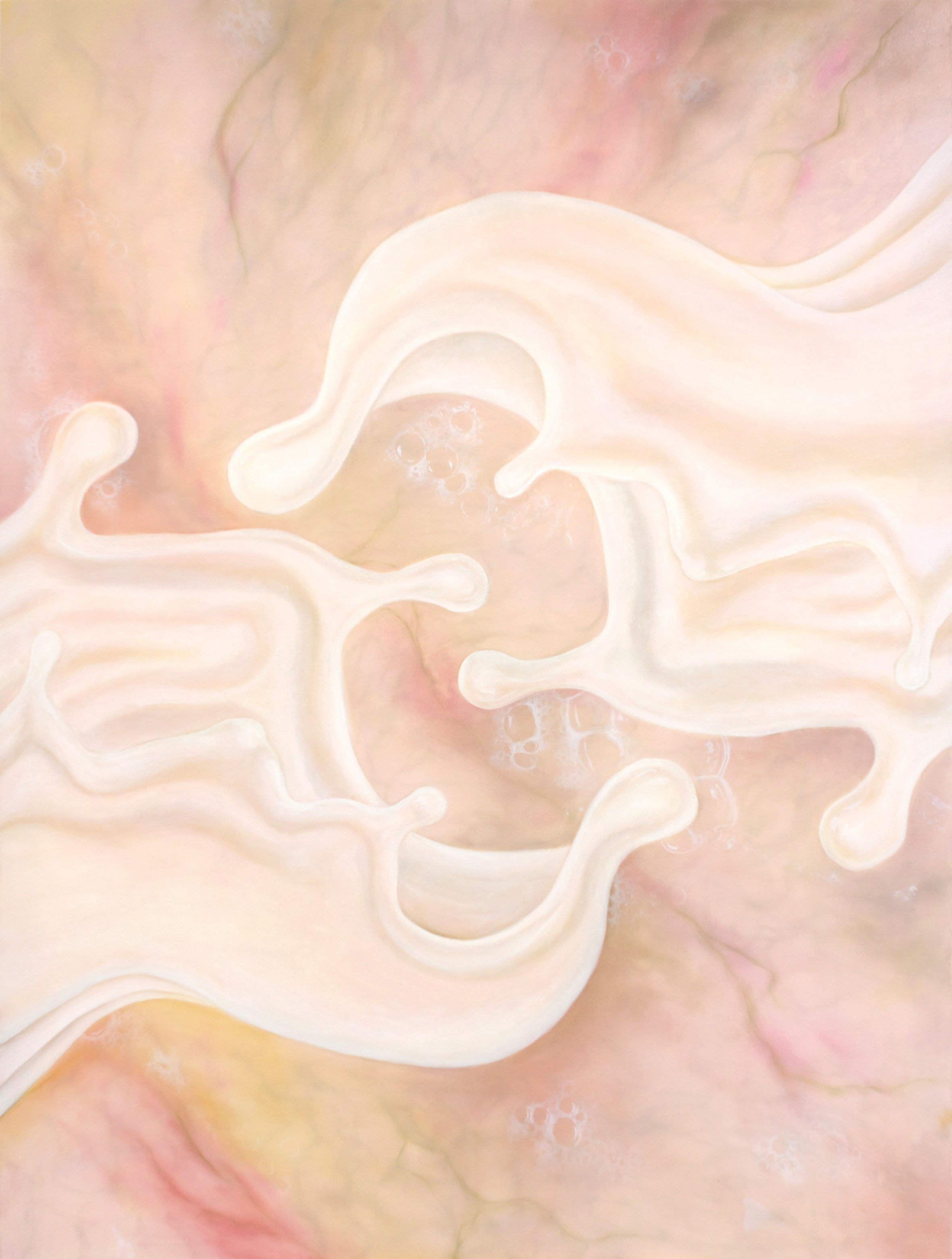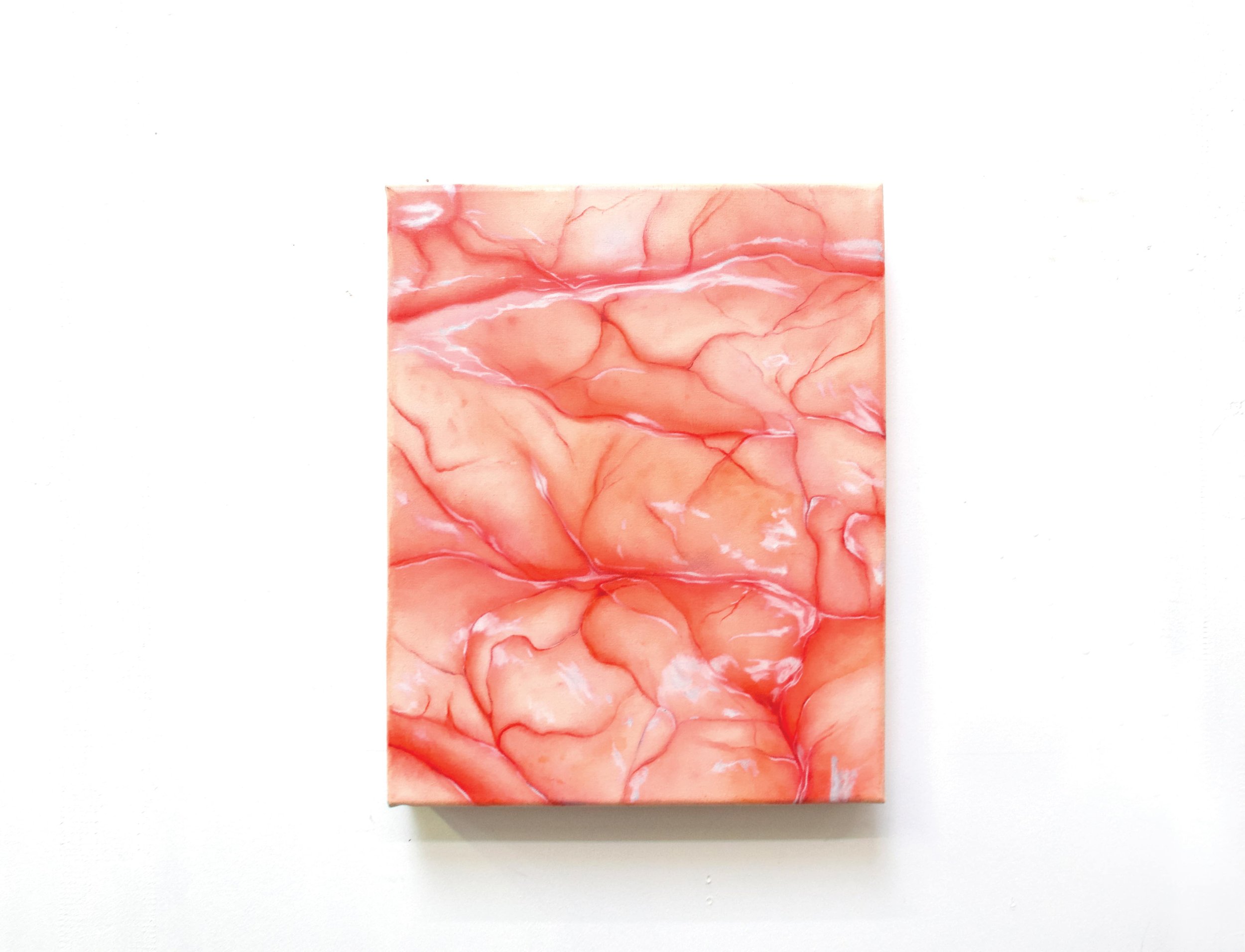Portrait of Carole Mousset in front of one of her paintings
Photo courtesy of the artist
Damaris Athene: Carole, can you please start off by introducing yourself?
Carole Mousset: I'm a French artist, but I have lived in Brussels for almost seven years now. I decided to come to Brussels to finish my master's degree in painting. In my work, I've always been interested in flesh. I've always wondered why and I think it’s because I had a disease when I was a teenager that changed my view of flesh. It's a time when your body is in a huge growing process and so it really changed the way I saw my own body. I had to put this in perspective. This was the time I started to watch gore movies and became interested in gore images and flesh stuff. It was a way to heal myself and I think it was a way to express how I was seeing my own body at the time. I think this is where it started. Since that moment, I like to see the body as a fluid container in constant mutation. Something really wet and fleshy. This is something that I like to call the body gaze, seeing the world with a fleshy prism. Everything if you reframe it can be organic. In my work I like to create viscous patterns that could be erotic also, because the matter is so soft and wet. I’m interested in the ambivalence between revulsion and attraction. I try to change people’s preconceptions about disgust.
DA: Thank you, it’s fascinating to hear how your interest in the body started. What draws you to work with different media?
CM: Mostly I do painting, but I like to mix it with sculpture and sometimes photography. For photography I often mix photos I have taken with photos I have found on the internet to create a wall texture. I like to print the photos on glue backed paper that you can stretch on the wall and to present the paintings on top of it, creating different layers of pattern. For sculpture I like to do frames for my painting. I’ve been doing ceramics for two years now. For me ceramics and painting are very similar, there is this slowness in the process. It takes time and it's about soft shapes. For me, it's another way to talk about fluids and flesh. I like the fact that the painting and sculpture can be in dialogue with each other. The glaze on the clay is really shiny and I can find in ceramics some things that I really like in painting. Sometimes I also bring a kinetic and sound side to my work; I made a few fountains. I was like, Okay, I work with body fluids, so why shouldn't I do some fun things! I have tried out a mixture of fluids, milk and coloured water. I also made an expanding foam sculpture that I covered in plaster, painted and coated in Paraffin wax and I used a mist maker with it. I really like expanding foam as it’s so easy to make body shapes, everything looks like organs.
Les Courants Lymphatiques (Body Cloud), 2021, Oil on canvas with ceramic, 35cm x 45cm x 5cm
Photo courtesy of the artist
DA: I hope I’m able to see some of your kinetic sculptures in real life one day! How did your painting style develop?
CM: Actually, when I started to paint human flesh I worked from screenshots of gore movies. It was very explicit and gory. I liked the provocative side of it but you don't say anything with that. So after that, I reframed the images and I started to abstract them. Now, I always have a balance between abstraction and realism. I try in my painting to make people understand that it comes from something real. In the process of abstraction I change the colours or reframe things. The paintings have become more and more blurry and focus on shiny things.
DA: Are you still using a lot of reference images?
CM: Yeah, it really depends. Sometimes it's screenshots, not only from gore movies, but also from animal documentaries. Sometimes it's medical pictures, or macro pictures of plants, or a 3D texture that I found on the internet. I don't have a specific source for my painting, I like to mix everything. I take inspiration from everywhere.
DA: It's really interesting to see what comes into your paintings, because there's so much that goes behind every artwork, isn't there? How does the body and bodily fluid feature in your practice?
CM: So it's by the representation of them and sometimes I show real fluids, often either water or milk, but I try to make people think about other fluids. Lately, I did a series of paintings about milk, but actually everybody says it looks like semen! It can therefore be seen as a non-binary biofluid. I like the fact that you can see whatever you want in the four big paintings. I took a mixture of milk splash 3D images from the internet, mirrored the image or took a small part of it and then put that in front of a marbled skin texture. What I like the most about body fluids is the fact that it makes everything shiny. In painting it's really cool to paint the small white sparkles. Representing fluids is also a way to express movement, matter that is constantly flowing and evolving.
Trouble Minded, 2021, Ceramic, water, food colouring, pump & plastic pipe, 56cm x 45cm x 50cm approx.
Photo courtesy of the artist
DA: How do you develop ideas? What’s your process when making the ceramic frames?
CM: It depends, sometimes I start with the frame or sometimes the painting. It’s difficult with ceramics because it shrinks when it has been fired so it's quite difficult to adapt it to the painting. Sometimes I just have an idea for a frame. Lately I did one with roses, things that look like a huge vulva actually! I don't have a painting for that yet so now I'm trying to think about one. Sometimes I just do a frame and then I have a painting at my studio that it will really fit together with. I don't have a specific process for that. Right now I'm working on a project where I’m doing corners as it would be really difficult to do big frames for big paintings. With the corners you can put them on every size. I like the fact that it's not a frame, it's just ornamental. I'm doing corners for a painting which is the surface of a swamp. It looks like a numeric pattern actually, but it's water. I'm making white enamel corners that colonise the wall and can colonise the painting too. I’m realising that I like doing ceramics where it can go with different paintings. I think it's sad to just decide that this frame is going to go with that painting and that's it. I prefer to make ornaments, things that go on the side of one painting that can dialogue with different paintings.
DA: Have you shown much of your ceramics and paintings together?
CM: I've shown ceramic frames with paintings in group shows, but I have never shown them all at once. Actually, this is something I would really like to do, to exhibit all the frames and all the paintings on a wall with maybe a picture behind it. That would be really cool.
DA: That would be amazing. I hope you get an opportunity to do so! Has the way you work been affected by the pandemic?
CM: I worked a lot from my place during the pandemic during the lockdown. I developed a small canvas series and I painted a lot. I had a lot of time, because the store where I was working was closed. It was strange and interesting, because I was working on body fluids at a time when you had to hide them. I wanted to work on something that was even more taboo at that moment. That's when I decided to work on saliva for an installation in Liege behind a window, and then decided to paint huge milk splashes.
L'équilibre des courants cosmiques, 2020-21, Oil on canvas, 160cm x 120cm
Photo courtesy of the artist
DA: An interesting time to be thinking about fluids and infection! What would you like people to get from your work
CM: I’m interested in changing the relationship that they have with disgust. I like it when they see my painting and they think there is something aesthetic about it, something that they're attracted to and then when I tell them what the subject is they're like, ‘Oh my God’. I really like it when you change their way of seeing disgust and it makes them change the way they see their own body. I like creating science fiction fantasy worlds with flesh images that focus on texture. I’m proposing new texture worlds, something dreamy and weird at the same time.
DA: Whose work inspires you?
CM: I would say the most important inspiration for me is David Cronenberg. I really like the concept that he created of body horror. He created a cinema theory which he calls ‘creative cancer’, filming things with the ‘disease prism’, seeing the world with the point of view of a sick or wounded body. It's like the body gaze that I was talking about earlier. I also like the paintings of two young artists. One is British and she’s called Elsa Rouy, and the other one I think she's American, she’s called Rae Klein. They both did a show at a gallery in Antwerp called Everyday Gallery. They do blurry shiny things. I really like the dreamy world Rae Klein is painting, everything is so delicate, and Elsa Rouy is so gory, and there's something really feminist that you can feel in her work that I really like. Also Joey Holder who does multimedia installations inspired by biology, science, and technology.
Texture #2, 2021, Oil on canvas, 30cm x 24cm
Photo courtesy of the artist
DA: A great selection! What projects have you been working on recently?
CM: At the end of May I exhibited in a group show for Antwerp Art Weekend curated by the Belgium curator Zeynep Kubat. She curated the show ‘Sugar for the Pill’ with 10 women artists. It's about self love and self care and fluids. She was inspired by Hildegard von Bingen, a nun from the 12 century who came up with humoral theory.
DA: That sounds amazing. Congratulations on the show! What plans have you got for future work?
CM: I would like to go back to making huge paintings in my studio, because it's been a while now. I'd like to do a swampy series, green fleshy things. I'd like to do a series about nature and the body and to paint nature as a wounded body.
DA: I can’t wait to see what you make! Thank you so much Carole. It was fascinating hearing about your practice. I hope I’m able to see your work in person in the not too distant future!
CM: Thanks so much!
Stay Hydrated (detail), 2022, Oil on wood, paraffin & epoxy, 44cm x 92cm x 2cm
Photo courtesy of the artist
